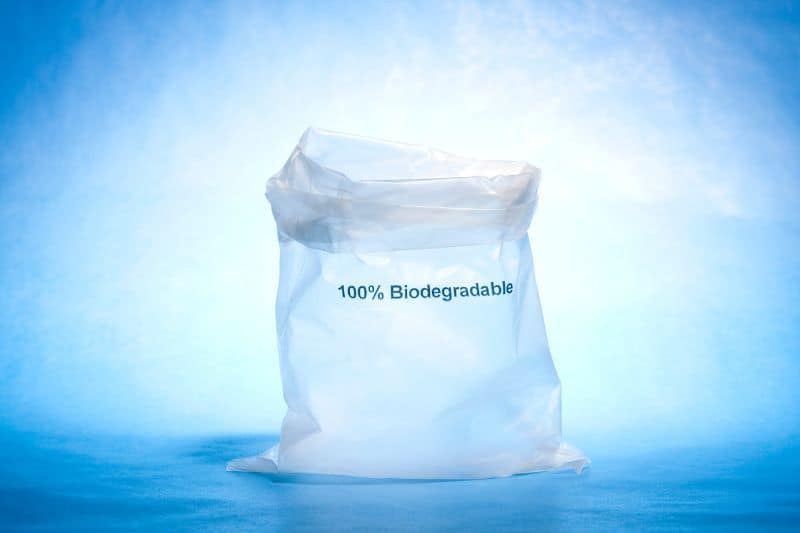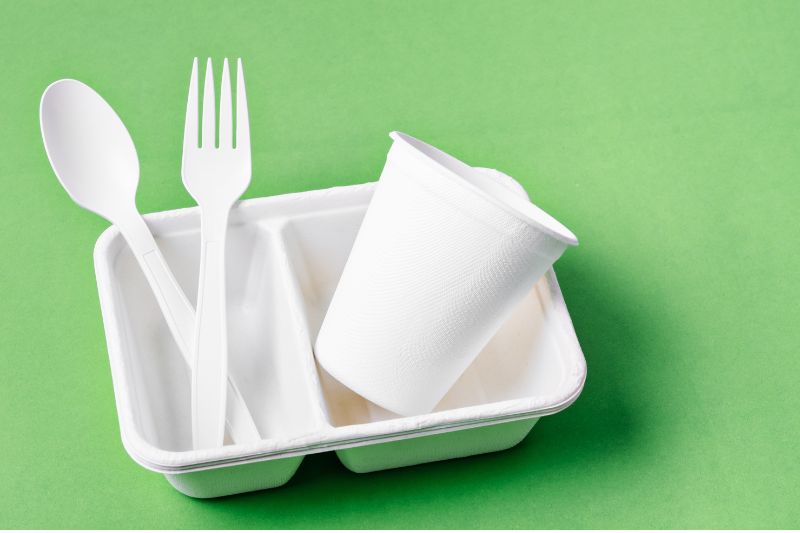Biodegradable plastics are plastics that are capable of going through the process of degradation by the biological action of organisms or after being subjected to an environment that makes them easily break down.
This is unlike the traditional plastics that are designed to last for a very long time. Because of the chemical structure of traditional plastics, they are resistant to the natural processes of degradation.
The quickest way of destroying them is by incineration, which increases carbon emissions, further contributing to air pollution and climate change. For this reason, biodegradable plastics are an alternative to the mess of plastics.
As the name suggests and as hinted earlier, they are plastics that break down, degrade, or decompose upon being exposed to bacteria, living organisms, rodents, insects or pests, water or dampness, ultra-violet radiation, sunlight, wind abrasions, enzymes, or biological action.
Furthermore, no carbon or chemical fillers are used in the manufacture of biodegradable plastics, and as such, they do not release carbon, methane, or other pollutants into the atmosphere when they decompose or are recycled.
As a result, biodegradable plastics contribute to a cleaner environment by reducing land, air, and water pollution.
For more information about biodegradable plastics, this article talks about how biodegradable plastics are made, the types of biodegradable plastics, and the problems with biodegradable plastics.
How Are Biodegradable Plastics Made?
Unlike traditional plastics, which are commonly made from petroleum products, the biodegradable variant is made from all-natural plant materials. That could include starch, corn oil, orange peels, and plants.
The petrochemicals used to make the traditional plastics are the reason there are carbon emissions when they are melted down. They are harmful to the environment and further contribute to global warming and climate change.
Biodegradable plastics are made from sources that contain no chemical fillers, thereby eliminating the risks posed to the environment by traditional plastics. This is a simple home guide on how biodegradable plastics are made. It also reflects how they can be made on a large scale at the industry level:

Step 1: Gathering Materials
As already mentioned, biodegradable plastics are made from all-natural plant materials. To make one, therefore, you’ll need the following:
- Corn starch
- Cooking oil
- Water
- 1 Spoon
- 1 microwavable container
- 1 Microwave
Step 2. Get your Proportions Right
You will measure one tablespoon of cornstarch, one-and-a-half tablespoon of water, and three to five drops of cooking oil. Ensure to stick to this ratio to avoid ruining the process.
Step 3. Preparation
The preparation stage involves mixing the ingredients in the microwavable container until a milky-looking liquid is formed.
Step 4. Microwaving
The mixture is then placed in a microwave at high temperatures for about 30 seconds. It will start to bubble and will become slightly transparent. It is important to keep an eye on the mixture, lest something goes wrong.
As soon as the mixture becomes slightly transparent, it should be removed from the microwave. It should then be left to cool down a bit before handling.
Step 5. Molding the Plastic
The product is now ready to be molded into the plastic. Here, the plastic is kneaded until it becomes soft enough to be molded like playdough. It can then be molded into whatever shape one desires.
After making the plastic product, it should be left undisturbed for about 24 hours for it to solidify and cure properly.
Step 6. Coloring and Use
Food coloring can be incorporated to add a splash of color to the product. For home applications, there’s a myriad of creative options, like using these products as plant pots for indoor cultivation.
When the plants mature, these biodegradable pots can be planted directly into the ground without concerns, as they’ll naturally break down over time, allowing the roots to seamlessly integrate with the soil.
Other homemade items could involve crafting a pocket watch encased in leather, producing rubber bands in unique shapes, or creating heart-shaped ornaments to adorn your home or other objects.
Types of Biodegradable Plastics
Now that you know something about biodegradable plastics, let’s move on and examine the types.
They include the following:
1. Oxo-biodegradable Plastics
Plastics that fall under this type degrade through oxo-degradation — degradation from the cell-mediated and oxidative techniques. Small amounts of pro-degradant additives that break the molecular chains in the polymer are introduced into the manufacturing process, changing the behavior of the end product.
When the product’s programmed service life is over, as controlled by the formulation of the additive, and it is no longer required, degradation begins. Such products can also be made with the same machinery and workforce that produces traditional plastic products, only that there is the introduction of the additive at little to no additional costs.
The product is consumed by fungi and bacteria after the additive reduces the molecular structure of the plastic to a level that can allow the microorganisms to access the carbon and nitrogen. The plastic biodegrades until all that is left is carbon dioxide, water, and humus, leaving no petrochemicals in the soil.
Oxo-biodegradable plastics have been certified as safe for use with all food types at high temperatures and are also being used for direct contact with organic foods. These include oxo-biodegradable films, plastic carrier bags, containers for packing frozen foods, and more, which are used all over the world and by giant corporations in the food industry.
2. Hydro-biodegradable Plastics

They are plastics whose biodegradation is initiated by hydrolysis — a chemical reaction in which water reacts with a compound to produce other compounds. The plastics under this category are made from renewable resources. They contain starch contents and oil.
In some instances, genetically modified crops have also been used to manufacture hydro-biodegradable plastics. The process of making the plastics involves using crops that releases greenhouse gases, thereby making the plastics not genuinely ‘renewable’.
Nonetheless, hydro-biodegradable plastics are made from sources such as sugar cane, corn, wheat, and petroleum-based sources. They degrade and biodegrade at a faster rate as compared to oxo-biodegradable plastics.
Such plastics are about 400% more expensive and are not as strong to use in high-speed machinery. They also emit methane, use about 300% more energy to produce, and are bulky and heavy. They are, however, not strong enough, especially when wet.
3. Photo-degradable Plastics
It is a less-known type of biodegradable plastic but exists nonetheless. They react and degrade after being subjected to ultraviolet light. Unless they are also oxo-biodegradable, they do not degrade in a landfill, sewer, or other dark environments.
Problems With Biodegradable Plastics
While the whole idea of biodegradable plastics is genius, it’s worth noting that these plastics come with its fair share of drawbacks. Let’s explore some of the problems associated with them:
1. There Are Mandatory Conditions for Decay or Degradation to Occur
Even if they are labeled ‘biodegradable’, plastics do not decay as banana peels would. They have to be exposed to some conditions like high temperatures and sunlight for the decay to occur. They also take longer to decay, and without the necessary conditions, they may even fail to decompose.
For instance, there are claims that oxydegradable plastics cannot be anaerobically digested or effectively composted, and for these reasons, they may not often break down in landfills.
2. Biodegrading Requires Sunlight to Breakdown, Making It a Problem for The Oceans and The Landfills
As plastics are usually washed away into oceans, the biodegradable ones equally present with almost similar problems as the traditional ones, minimizing the chances of them decomposing.
Let’s take the photo-degradable plastics, for example. They are designed to degrade at temperatures higher than 50°C, meaning they cannot biodegrade if they are in the ocean.
A problem with these biodegradable plastics is that they have to be exposed to direct sunlight. Such plastics are not buoyant, meaning they sink in the ocean, further placing them away from the direct sunlight that would aid in their biodegradation. It also means they would not decay as they should if buried in a landfill.
3. High Costs of Production

Biodegradable plastics are known to require a lot of energy and oil to make. For instance, 1kg of polylactic acid, which is a commonly used bioplastic, requires 2.65 kg of corn to make. It, therefore, makes no sense to design a product that requires so much to make yet self-destruct.
4. Their Cost to The Environment is Equally High
Biodegradable plastics have also been criticized for not being all different from conventional plastics. For 270 million tonnes of plastic produced each year, it requires about 715 million tonnes of corn, which has a huge cost on the environment.
Additionally, using a significant quantity of food in plastic production raises concerns, especially in the face of global warming and climate change, which are affecting crop yields.
Given the assumption of ample food resources, a more sensible approach might be to allocate this produce to countries grappling with hunger crises, addressing pressing humanitarian needs rather than diverting it towards plastic manufacturing.
5. Biodegradation Should Not Be Happening in Homes
As already mentioned, the biodegradable plastics do not decay as banana peels would. They have to be set in specific conditions for them to decompose as intended.
This, therefore, means biodegradation should be taking place or should happen in industrial composting facilities, not in our homes. Unfortunately, placing them in a landfill will not provide the necessary conditions for decomposition.
6. Their Effect on The Ocean is Harmful to Marine Life
Although they are labeled ‘biodegradable’, these plastics cannot simply degrade because the ocean lacks the conditions necessary to promote decay.
The oceans may sometimes be too cold, thus preventing their effective breakdown — floating forever on the water surface (depending on the materials used in the manufacture) just like conventional plastic.
In the event they break down, these plastics leave behind tiny fragments that cause harm to marine life. The tiny fragments can be confused for food, which may adversely affect aquatic life to the point of killing them.
Plus, these plastics can sometimes also entangle on the bodies of the animals, hindering their swimming, hunting, and flying abilities, making them easier targets for predators. They could also starve to death as they are unable to feed themselves.
References:
Kinhal, V. (n.d). Types of Biodegradable Plastic. Lovetoknow Retrieved 12 March 2020 from https://greenliving.lovetoknow.com/Type_of_Biodegradable_Plastic
Oakes K. (5 Nov, 2019). Why biodegradables won’t solve the plastic crisis. BBC Future. Retrieved 12 March 2020 from https://www.bbc.com/future/article/20191030-why-biodegradables-wont-solve-the-plastic-crisis
Woodford, C. (10 Feb, 2020). Bioplastics and biodegradable plastics. Explainthatstuff! Retrieved 12 March 2020 from https://www.explainthatstuff.com/bioplastics.html






